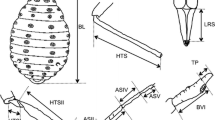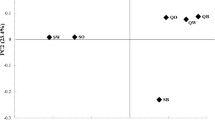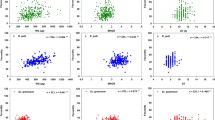Abstract
The genetic and morphological differentiation of insect populations in relation to the use of different host plants is an important phenomenon that predates ecological specialisation and speciation in sympatric conditions. In this study, we describe the morphological variation of populations of Brevicoryne brassicae (Homoptera: Aphididae) associated with two host species, Brassica oleracea and Brassica campestris, which occur sympatrically in the highlands of Chiapas, Mexico. The study is aimed at obtaining evidence regarding phenotypic differentiation induced by, or associated with, the use of distinct but closely related host species. Seven morphological characters were measured in 696 wingless aphids collected from plants of the two host species at four localities. Morphological variation was summarised through principal components analysis (PCA). Sixty-two percent of morphological variation was explained by the first two PCs. The first component (PC1) was related to the general size of appendages, and PC2 was interpreted as the relationship between body size (body and leg size) and antenna length. Aphids growing on B. campestris were bigger than those collected from B. oleraceae. Significant differences between hosts were detected for PC1, whereas a significant effect of locality, host, and the interaction locality × host was detected for PC2. These results indicate that the average phenotype of B. brassicae individuals inhabiting different host-plant species differs as a consequence of the contrasting feeding environments the host species provide.




Similar content being viewed by others
References
Ågren J, Schemske DW (1994) Evolution of trichome number in a naturalized population of Brassica campestris. Am Nat 143:1–13
Anstead JA, Burd JD, Shufran KA (2002) Mitochondrial DNA sequence divergence among Schizaphis graminum (Hemiptera: Aphididae) clones from cultivated and non-cultivated hosts: haplotype and host associations. Bull Entomol Res 92:17–24
Ashford DA, Smith WA, Douglas AE (2000) Living on a high sugar diet: the fate of sucrose ingested by phloem-feeding insect, the pea aphid Acyrthosiphon pisum. J Insect Physiol 46:335–341
Berlocher SH, Feder JL (2002) Sympatric speciation in phytophagous insects: moving beyond controversy? Annu Rev Entomol 47:773–815
Blackman RL (1987) Morphological discrimination of a tobacco-feeding form from Myzus persicae (Sulzer) (Hemiptera: Aphididae), a key to new world Myzus (Nectarosiphon) species. Bull Entomol Res 77:713–730
Blackman RL, Eastop VF (2000) Aphids on the world’s crops. An identification and information guide, 2nd edn. Wiley, London
Blackman RL, Paterson AJC (1986) Separation of Myzus (Nectarosiphon) antirrhinii (Macchiati) from Myzus (N.) persicae (Sulzer) and related species in Europe (Homoptera: Aphididae). Syst Entomol 11:267–276
Bush GL (1994) Sympatric speciation in animals: new wine in old bottles. Trends Ecol Evol 9:285–288
Carroll SP, Boyd C (1992) Host race radiation in the soapberry bug: natural history with the history. Evolution 46:1052–1069
Chen JQ, van Rhabé Y, Delobel B, Sauvion N, Guillaud J, Febvay G (1997) Melon resistance to the aphid Aphis gossypii: behavioural analysis and chemical correlations with nitrogenous compounds. Entomol Exp Appl 85:33–44
Damsteegt VD, Voegtlin DJ (1990) Morphological and biological variation among populations of Aulacorthum solani (Homoptera: Aphididae). Ann Entomol Soc Am 83:949–955
Dixon AFG (1998) Aphid ecology. Chapman & Hall, London
Dixon AFG, Kindlmann P (1994) Optimum body size in aphids. Ecol Entomol 19:121–126
Eastop VF (1985) The acquisition and processing of taxonomic data. In: Szelegiewicz H (ed) Proceedings of the international aphidological symposium, Jablonna, Ossolineum, Wroclaw, Poland, pp 245–270
Fox LR, Morrow PA (1981) Specialization: species property or local phenomenon? Science 211:887–893
González-Espinosa M, Ochoa-Gaona S, Ramírez-Marcial N, Quintana-Ascencio PF (1997) Contexto vegetacional y florístico de la agricultura en Los Altos de Chiapas. In: Parra-VR, Díaz-Hernández B (eds) Agricultura y crisis rural, Tomo I. Recursos Naturales, El Colegio de la Frontera Sur. San Cristóbal de las Casas, Chiapas, México, pp 110–135
Heie OE (1987) Morphological structures and adaptations. In: Minks AK, Harrewijn P (eds) World crop pests, aphids their biology, natural enemies and control. Elsevier, Amsterdam, pp 393–400
Lazzari SMN, Voegtlin DJ (1993) Morphological variation in Rhopalosiphum padi and R. insertum (Homoptera: Aphididae) related to host plant and temperature. Ann Entomol Soc Am 86:26–36
Louda S, Mole S (1991) Glucosinolates: chemistry and ecology. In: Rosenthal GA, Berenbaum MR (eds) Herbivores, their interactions with secondary plant metabolites, 2nd edn. Academic Press, Oxford, pp 123–164
Meyers LA, Bull JJ (2002) Fighting change with change: adaptive variation in an uncertain world. Trends Ecol Evol 17:551–557
Montoya-Gómez G (1998) Participación de los productores campesinos en el mercado de hortalizas en Los Altos de Chiapas: El caso de la papa. In: Reyes-Ramos ME, Moguel-Viveros R, Van der Harr G (eds) Espacios disputados: transformaciones rurales en Chiapas, Universidad Autónoma Metropolitana y El Colegio de la Frontera Sur, México DF, pp 187–209
Moran N (1981) Intra specific variability in herbivore performance and host quality: a field study of Uroleucon caligatum (Homoptera: Aphididae) and its Solidago hosts (Asteraceae). Ecol Entomol 6:301–306
Moran N (1986) Morphological adaptation to host plants in Uroleucon (Homoptera: Aphididae). Evolution 40:1044–1050
Moran N (1992) The evolutionary maintenance of alternative phenotypes. Am Nat 139:971–989
Nagel L, Schluter D (1998) Body size, natural selection, and speciation in sticklebacks. Evolution 52:209–218
Nosil P, Crespi BJ (2004) Does gene flow constrain adaptive divergence or vice versa? A test using ecomorphology and sexual isolation in Timema cristinae walking sticks. Evolution 58:102–112
Pappers MS, van Dommelen H, van der Velde G, Ouborg NJ (2001) Differences in morphology and reproductive traits of Galerucella nymphaeae from four plant species. Entomol Exp Appl 99:183–191
Roff DA (1992) The evolution of life histories, theory and analysis. Chapman & Hall, New York
Rollins RC (1993) The Cruciferae of continental North America. Stanford University Press, Palo Alto
Rollins RC, Banerjee UC (1976) Trichomes in studies of the Cruciferae. In: Vaughan JG, Macleod AJ, Jones BMG (eds) The biology and chemistry of the Cruciferae. Academic Press, New York, pp 145–167
Ruiz-Montoya L, Núñez-Farfán J (2004) Local adaptation of Brevicoryne brassicae (Homoptera: Aphididae) to host plant at Los Altos de Chiapas, Mexico. In: Simon JC, Dedryver CA, Rispe C, Hullé M (eds) Aphids in a new millenium, Institutte National de la Recherche Agronomique (INRA) Paris, France, pp 261–266
Ruiz-Montoya L, Zuñiga-Bermúdez G, Peña-Martínez R (1994) Morphological variation of Eriosoma lanigerum (Homoptera: Aphididae) on Pyracantha koidzumii in Mexico City. Ann Entomol Soc Am 87:108–115
Ruiz-Montoya L, Núñez-Farfán J, Vargas J (2003) Host-associated genetic structure of Mexican populations of the cabbage aphid Brevicoryne brassicae (Homoptera: Aphididae). Heredity 91:415–421
Sandström J (1994) Performance of pea aphid (Acyrtosiphon pisum) clones on host plants and synthetic diets mimicking the same plants phloem amino acid composition. J Insect Physiol 40:1051–1057
SAS Institute (1995) JMP statistics and graphics guide. Version 3.1. SAS, Cary
Schlichting CD, Pigliucci M (1998) Phenotypic evolution, a reaction norm perspective. Sinauer Associates, Sunderland, MA
Schluter D (1995) Adaptive radiation in sticklebacks: trade-offs in feeding performance and growth. Ecology 76:82–90
Schluter D (2001) The ecology of adaptive radiations. Oxford University Press, London
Shaposhnikov GCH (1985) The main features of the evolution of aphids. In: Szelegiewicz H (ed) Proceedings of the international aphidological symposium, Jablonna, Ossolineum, Wroclaw, Poland, pp 19–99
Sokal RR, Unnasch RS, Thomson BA (1991) Pemphigus revisited: changes in geographic variation but constancy in variability and covariation. Evolution 45:1585–1605
Stowe KA (1998) Experimental evolution of resistance in Brassica campestris: correlated response of tolerance in lines selected for glucosinolate content. Evolution 52:703–712
Sultan SE, Spencer HG (2002) Metapopulation structure favors plasticity over local adaptation. Am Nat 160:271–283
Takada H (1979) Characteristics of forms of Myzus persicae (Sulzer) Homoptera: Aphididae) distinguished by colour and esterase differences and their occurrence in populations on different host plants in Japan. Appl Entomol Zool 14:349–360
Underwood AJ (1997) Experiments in ecology. Their logical design and interpretation using analysis of variance. Cambridge University Press, Cambridge
Via S (1987) Genetic constraints on the evolution of phenotypic plasticity. In: Loeschcke V (ed) Genetic constraints on adaptive evolution. Springer-Verlag, Berlin Heidelberg, pp 46–71
Via S (2001) Sympatric speciation in animals: the ugly ducking grows up. Trends Ecol Evol 16:381–390
Via S (2002) The ecological genetics of speciation. Am Nat 159:S1–S7
Via S, Shaw AK (1996) Short-term evolution in the size and shape of pea aphids. Evolution 50:163–173
Weber G (1985) Genetic variability in host plant adaptation of the green peach aphid Myzus persicae. Entomol Exp Appl 38:49–56
Weisser WW, Stadler B (1994) Phenotypic plasticity and fitness in aphids. Eur J Entomol 91:71–78
Acknowledgements
We are grateful to Manuel Girón-Intzín and Vianey Méndez-Trujillo for technical assistance. We deeply appreciate the statistical advice offered by Duncan Golicher. We thank Martín Aluja, Rodolfo Dirzo, Carlos Cordero, Fabián Vargas and Shelly Lachys for reading and commenting on the manuscript. CONACyT (31543-B and 990039-DO-LRM), and ECOSUR Project 7-Dinamica de Poblaciones y Comunidades de Insectos provided funds for this study. This work is a partial fulfilment of the doctoral dissertation of LRM.
Author information
Authors and Affiliations
Corresponding author
About this article
Cite this article
Ruiz-Montoya, L., Nùñez-Farfán, J. & Domínguez, C.A. Changes in morphological traits of the cabbage aphid (Brevicoryne brassicae) associated with the use of different host plants. Ecol Res 20, 591–598 (2005). https://doi.org/10.1007/s11284-005-0076-3
Received:
Accepted:
Published:
Issue Date:
DOI: https://doi.org/10.1007/s11284-005-0076-3




